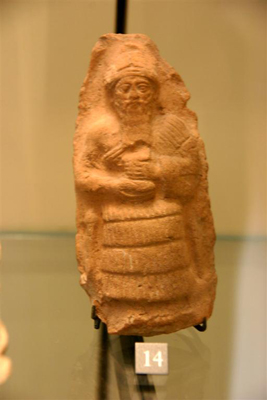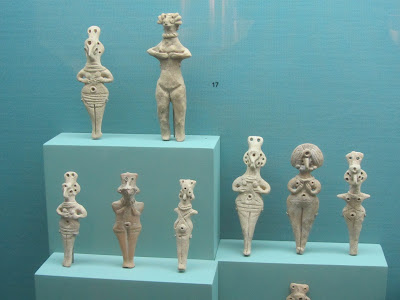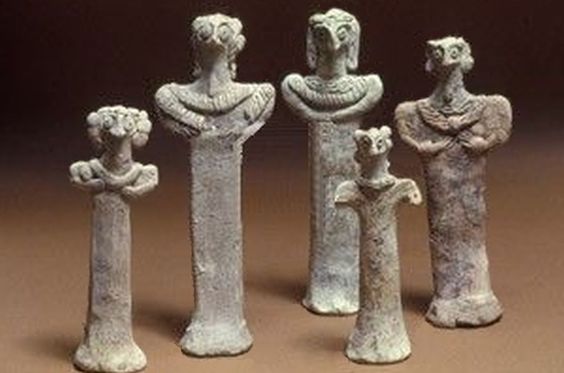Teraphim Bible Dictionary
Images of the size and form of a man (1 Sam. 19:13, 16) used from patriarchal times (Gen. 31:30, 32) and onwards (Judg. 17:5; Hosea 3:4–5; Zech. 10:2) in worship and for magical purposes both in Israel and in Babylon (Ezek. 21:21). To use teraphim was probably not to worship strange gods but to worship the true God in a corrupt manner.
Teraphim Genesis 31.19
“Now Laʹban had gone to shear his sheep, and Rachel stole the teraphim statues that belonged to her father.” New World Translation
“And Laban went to shear his sheep: and Rachel had stolen the images that were her father’s.” King James Version
Teraphims were sometimes consulted to make predictions. – “For the king of Babylon stood at the parting of the way, at the head of the two ways, to use divination: he made his arrows bright, he consulted with images, he looked in the liver.” Ezekiel 21:21
Worshipping Through the Spirit
Worshipping the Lord through the spirit is crucial. We don’t need an object or book or other item in order to worship Him in spirit and truth. To understand worshipping vs receiving the word of the Lord can be very different. For example. You don’t need an idol or image called Teraphim, to worship God, but you may feel a need of having a representation of God close by, in order to better focus your attention on the word of God. Maybe like a prayer rock. The rock is there to remind us to pray, not an item to pray too. Perhaps this is how the ancients misused the Teraphim. A prophet used it to get into the spirit of worship or be surrounded by things that help him get into the focus a prophet needs, and a non prophet used it to pray to for guidance and looking for answers from the image. We could look at that in the use of a statue or picture of Mary today in some churches. We shouldn’t worship the picture or statue, but let it help us get in tune with the spirit.
I believe a big reason the Church of Jesus Christ of Latter-day Saints seldom has a picture or statue of Christ in the Chapel is for this reason. If during sacrament meeting our mind and eyes are fixed on a specific image of Christ or a specific statue of Christ, our heart may not be reflecting on the true God, as we should worship through the power of the spirit and not of the image. Some people see a certain picture of Christ and it may recall a good feeling and others may see the same picture and not like that version of the picture and it takes their mind off of the spirit and focuses too much on that particular picture.
Thus, to use teraphim or an image or a statue was probably not to worship strange gods but to worship the true God in a corrupt manner as the Bible Dictionary above says. Worshipping the true God through the true manner would not need a picture or idol, but only your internal personal picture or image you may see personally, as you worship in spirit and truth.
It may be like Moses’ staff in the wilderness. That seems to me to be a lesser law of worship than we know today, but looking simply on the staff and serpent saved many people from their destruction. Sometimes the simplicity of the commandment makes many not believe it is of God. In our Church today think of the consistent council our Bishop and leaders give us. They simply say, read scriptures, pray daily, fast and attend your meetings to partake of the Sacrament. To some that seems too easy but simply obeying your leaders in simple things usually will work in getting you to feel the Spirit in a more focused way. I may actually look at the ancient Teraphim as today’s Prayer, Scriptures, Sacrament, Temple picture, picture of the First Presidency, or our favorite picture of Christ in our home.
Teraphim, or Urim and Thummim
“The book of Mormon, as a revelation from God, possesses some advantage over the old scripture: it has not been tinctured by the wisdom of man, with here and there an Italic word to supply deficiencies. It was translated by the gift and power of God, by an unlearned man, through the aid of a pair of Interpreters, or spectacles—(known, perhaps, in ancient days as Teraphim, or Urim and Thummim) and while it unfolds the history of the first inhabitants that settled this continent, it, at the same time, brings a oneness to scripture, like the days of the apostles; and opens and explains the prophecies, that a child may understand the meaning of many of them; and shows how the Lord will gather his saints, even the children of Israel, that have been scattered over the face of the earth, more than two thousand years, in these last days, to the place of the name of the Lord of hosts, the mount Zion.
It may be well to state, that the prophet of God, in ancient days, according to the accounts of men, kept their sacred records on plates of gold, and those of less consequence on plates of brass, copper, wood, &c., see Jahn’s biblical archeology, Josephus, and others. These plates were generally made from the sixteenth to the thirty second part of an inch thick (of metal) and something like six by eight inches square, and fastened at the back with three rings through which a rod was put to carry them, or hang them. The word of the Lord, the history of the doings of the children of God, and their genealogy was engraved in a nice workmanlike manner, upon them, in Hebrew, reformed Egyptian, &c. Such was the condition of the plates, from which came the book of Mormon. As may be seen by an allusion in the book of Ether, all that was on them is not translated; wherefore, as they are sacred, when the Book of Mormon was translated from them, they were again hid up to the Lord, to come forth again in his own due time. The Ark of the covenant containing the sacred stone tables, was hid up to the Lord, in the cave where Moses climbed up to view the heritage of God, and was not to come forth till God received his people again unto mercy, when all these things and the cloud shall return, and the glory of God shall rest upon his temple. The present generation is great with events.” 1833 January The Evening and the Morning Star https://catalog.churchofjesuschrist.org/assets/2747dc8d-2b2e-45e1-88da-a335c0436deb/0/1
Teraphim
Hosea 3:4
“For the children of Israel shall abide many days without a king, and without a prince, and without a sacrifice, and without an image, and without an ephod, and without teraphim:”
IE domestic idols, perhaps in size and shape of a man. Judg. 18:18 (18, 20); 1 Sam. 19:13 (13, 16).
Judges 18:18, 20
18 And these went into Micah’s house, and fetched the carved image, the ephod, and the teraphim, and the molten image. Then said the priest unto them, What do ye?
20 And the priest’s heart was glad, and he took the ephod, and the teraphim, and the graven image, and went in the midst of the people.
1 Samuel 19:13, 16
13 And Michal took an image, and laid it in the bed, and put a pillow of goats’ hair for his bolster, and covered it with a cloth.
16 And when the messengers were come in, behold, there was an image in the bed, with a pillow of goats’ hair for his bolster. https://www.churchofjesuschrist.org/study/scriptures/ot/judg/17.5?lang=eng&clang=eng#p5
Thummim
Perfection (LXX., “truth;” Vulg., “veritas”), Exodus 28:30 ; Deuteronomy 33:8 ; Judges 1:1 ; 20:18 ; 1 Samuel 14:3 1 Samuel 14:18 ; 23:9 ; 2 Sam 21:1 . What the “Urim and Thummim” were cannot be determined with any certainty. All we certainly know is that they were a certain divinely-given means by which God imparted, through the high priest, direction and counsel to Israel when these were needed. The method by which this was done can be only a matter of mere conjecture. They were apparently material objects, quite distinct from the breastplate, but something added to it after all the stones had been set in it, something in addition to the breastplate and its jewels. They may have been, as some suppose, two small images, like the teraphim (Compare Judges 17:5 ; Judges 18:14 Judges 18:17 Judges 18:20 ; Hosea 3:4 ), which were kept in the bag of the breastplate, by which, in some unknown way, the high priest could give forth his divinely imparted decision when consulted. They were probably lost at the destruction of the temple by Nebuchadnezzar. They were never seen after the return from captivity.
And I, Abraham, had the Urim and Thummim, which the Lord my God had given unto me, in Ur of the Chaldees” Abraham 3:1
“And thou shalt put in the breastplate of judgment the Urim and the Thummim; and they shall be upon Aaron’s heart, when he goeth in before the Lord: and Aaron shall bear the judgment of the children of Israel upon his heart before the Lord continually.” Exodus 28:30
7 And he put upon him the coat, and girded him with the girdle, and clothed him with the robe, and put the ephod upon him, and he girded him with the curious girdle of the ephod, and bound it unto him therewith.
8 And he put the breastplate upon him: also he put in the breastplate the Urim and the Thummim.
9 And he put the mitre upon his head; also upon the mitre, even upon his forefront, did he put the golden plate, the holy crown; as the Lord commanded Moses. Leviticus 8:7-9
Also, that there were two stones in silver bows—and these stones, fastened to a breastplate, constituted what is called the Urim and Thummim—deposited with the plates; and the possession and use of these stones were what constituted “seers” in ancient or former times; and that God had prepared them for the purpose of translating the book. JSH 1:35
“Having removed the earth, I obtained a lever, which I got fixed under the edge of the stone, and with a little exertion raised it up. I looked in, and there indeed did I behold the plates, the Urim and Thummim, and the breastplate, as stated by the messenger. The box in which they lay was formed by laying stones together in some kind of cement. In the bottom of the box were laid two stones crossways of the box, and on these stones lay the plates and the other things with them.” Book of Mormon Introduction- Testimony of Joseph Smith
Israeli boy finds 3,400-year-old Canaanite figurine during hike
While climbing the archaeological mound in Tel Rehov, Ori Greenhut discovers ancient female figurine, believed to be one of the Teraphim, idolatrous statues used during Biblical times.
A seven-year-old child recently discovered an ancient female figurine at the Tel Rehov archeological site in northern Israel. The figurine is estimated to be one of the Teraphim, idolatrous statues used during Biblical times.
Ori Greenhut, from the community of Tel Teomim, went on a hike with friends at the beginning of the week accompanied by the father of one of his friends. While climbing the archeological mound in Tel Rehov, Ori came across a stone that had been moved and suddenly saw a small figure covered in mud. He scraped off the mud and discovered the clay figurine.
“Ori came home with an impressive figurine and it was really exciting,” said Moriya Greenhut, Ori’s mother. “We explained to him that it is an antiquity and that the Antiquities Authority keeps the findings for the benefit of the general public.”
The Greenhut family gave the figurine to the Israel Antiquities Authority (IAA), and IAA representatives came to Ori’s school at Kibbutz Sde Eliyahu to award him a certificate of appreciation for his good citizenship. They also informed the class of details about the figurine, which depicts a naked woman and was made by pressing soft silt into a mold.
“It was incredible,” said Ori’s teacher. “The archeologists came into the class during a Torah lesson in which we had just learned about the Teraphim, statues that were used at the time for pagan idolatry. I suddenly understood that one of these Teraphim was here in the class with us!”
Hebrew University Professor Amihai Mazar, who directs the Tel Rehov excavation expedition, studied the figurine and concluded that it is approximately 3,400 years old and “typical of Canaanite culture between the 15th and 13th centuries BCE.”
“Some researchers believe the figurine depicts a mortal woman while others think it is a depiction of the fertility goddess Ashtoreth, known from the Bible and from Canaanite sources,” added Prof. Mazar. “There is a good chance that the term Teraphim in the Torah indeed refers to this kind of figurine.”
“The figurine seems to have belonged to one of the residents of the ancient city of Rehov, which had then been ruled by the pharaohs of ancient Egypt,” he added.
Judges 17:5: An Ephod, Teraphim, and an Illegitimate Priest
Verse 5: And the man Micah had an house of gods, and made an (Judg. 8:27) ephod, and (Gen. 31:19, 30; Hos. 3:4) teraphim, and consecrated (Heb. filled the hand, Ex. 29:9;1 Kings 13:33) one of his sons, who became his priest.
An house of gods, that is, an house or place consecrated for the service of God in this manner.

An ephod; an eminent part of the priestly garments, Exodus 28:4, which, some think, is here put for all of them.

[And Teraphim] That is, Images having a human figure; Hosea 3:4. They say that they made those images for the honor of God, led by a certain pretext of religion and superstition: which the jealous God abominates. That Micah was a worshipper partly of the true God, partly of idols. Every instrument of false religion is able to be understood here (Vatablus). Teraphim μορφώματα/shaped in the form of Cherubim, says Jerome to Marcella, both in 1 Samuel 22:18 and 2 Samuel 6:14, just as it appears that it is to be taken in Hosea 3:4. For it is a middle word, pertaining to images good and bad. If we follow this interpretation, we shall say that these Teraphim are called אֱלֹהִים/ Elohim/gods,[6] that is, angels, because they were signifying Angels. Now, the graven and earthen things were altars, a lampstand, and other lesser things of this sort, in the place of the great things that were in the Sanctuary; just as, Torquatus[7] constructed elegant baths of Parian marble, Otacilius[8] made kettles[9] (Grotius). [Francis Moncæius, who contends that the golden calf was fashioned by Aaron into the similitude of the Mosaic Cherubim, concerning which we spoke at length on Exodus 32, thinks similarly of Micah.] Micah [says he] and his mother fashioned a graven thing, etc., both an Ephod and Teraphim after the similitude of the Mosaic works of the same sort. Perhaps the graven and molten thing was like unto that sacred plate, Exodus 39:30, not indeed of gold, as in that place, but of silver, on which also, just as it was done on that, he saw to it that the name of the Lord was graven (Moncæius’ Concerning the Golden Calf 1:17). The Ephod agreed with the Mosaid Ephod, no less in form and use than in name (Moncæius’ Concerning the Golden Calf 1:18). The Teraphim agreed with the Mosaic Cherubim (Moncæius’ Concerning the Golden Calf 1:18). For the term Teraphim is not always taken in an ill sense, but is used indifferently of whatever image, sometimes even in a good way, as in Hosea 3:4. [Concerning which see what things are to be said on that passage σὺν Θεῷ, Lord willing.] Teraphim were household idols, which were worshipped in the home, and were consulted as oracles concerning matters arcane or future, their Penates and Lares, as it were[10] (Lapide). They appear to have been idols that gave responses to questions: as it is easily proven out of Ezekiel 21:21, …he consulted Teraphim; out of Zechariah 10:2, the Teraphim have spoken vanity; and out of 2 Kings 23:24, where after familiar spirits and wizards Teraphim are placed, as things conjoined, and have regard to divination and oracles (Bonfrerius). Moreover, either they are called Teraphim, that is, Seraphim, as it were; for the Chaldeans convert שׂ/S into ת/t: or images shameful, indecent, and filthy are called Teraphim; for to the Chaldean תרף/theraph signifies to putrefy, and to afflict with disgrace (Lapide). Now, Teraphim is a word of the plural number, the singular of which is not found.

Stolen Teraphim
Teraphim; some sort of images so called, of which see Genesis 31:19; Hosea 3:4.
[And he filled his hand] That is, with oblations, with which rite priests were initiated (Munster, similarly Vatablus, Menochius). See Exodus 28:41[11] (Piscator). To fill the hand of one is to introduce him into the possession of some matter. He next declares, and he was to him a priest (Vatablus). It is strange that a lay and profane man would rush into a consecration of this sort: but what is strange, if one that fashions gods for himself, should also forge priests? But evidently, of what sort of gods, such is the consecration, and such also the priests (Bonfrerius).
[Of one of his sons] Namely, the firstborn. Formerly the right of the priesthood belonged to such (Lapide, Serarius, Tostatus). But this account does not convince; for that right of the firstborn was annulled by the Aaronic priesthood, and Micah was able to employ any one of his sons in this work according to the manner of the Aaronic priests (Bonfrerius). He did this temporarily, until provision was made for him of a certain Levite (Junius, Malvenda).
[And he was made a priest for him] Evidently, because the priests were not publicly discharging their office, through fault, or because the regions were infested with brigandage, Micah actually supposed that God was to be worshipped by him in private religion; and so, although at first he had willed his own son to be a priest for him, he soon preferred the Levite he found to his son, so that he might approach as nearly as possible to the institutes of the Law. For he was worshipped the true God, יְהוָה/Jehovah/LORD, Judges 17:3, 13; 18:6. And God responds with true things to the one asking, Judges 18 (Grotius).

[1] Hebrew: וְהָאִ֣ישׁ מִיכָ֔ה ל֖וֹ בֵּ֣ית אֱלֹהִ֑ים וַיַּ֤עַשׂ אֵפוֹד֙ וּתְרָפִ֔ים וַיְמַלֵּ֗א אֶת־יַ֤ד אַחַד֙ מִבָּנָ֔יו וַיְהִי־ל֖וֹ לְכֹהֵֽן׃
[2] Genesis 31:19: “And Laban went to shear his sheep: and Rachel had stolen the images (הַתְּרָפִים, the teraphim) that were her father’s.
[3] Hebrew: וַיְמַלֵּ֗א אֶת־יַ֤ד.
[4] Exodus 29:9: “And thou shalt gird them with girdles, Aaron and his sons, and put the bonnets on them: and the priest’s office shall be theirs for a perpetual statute: and thou shalt consecrate Aaron and his sons (וּמִלֵּאתָ֥ יַֽד־אַהֲרֹ֖ן וְיַד־בָּנָֽיו׃, and thou shalt fill the hand of Aaron and the hand of his sons).”
[5] 1 Kings 13:33: “After this thing Jeroboam returned not from his evil way, but made again of the lowest of the people priests of the high places: whosoever would, he consecrated him (יְמַלֵּ֣א אֶת־יָד֔וֹ, he filled his hand), and he became one of the priests of the high places.”
[6] See Judges 18:24.
[7] Titus Manlius Torquatus (third century BC) was served as consul, censor, and ultimately dicatator in the Roman Republic.
[8] Manius Otacilius Crassus was a third-century BC Roman consul.
[9] Thus Martial.
[10] Among the Romans, the Penates and Lares were household deities.
[11] Exodus 28:41: “And thou shalt put them upon Aaron thy brother, and his sons with him; and shalt anoint them, and consecrate them (וּמִלֵּאתָ֧ אֶת־יָדָ֛ם, and fill their hand), and sanctify them, that they may minister unto me in the priest’s office.”
https://www.fromreformationtoreformation.com/post/judges-17-5-an-ephod-teraphim-and-an-illegitimate-priest
Household Idols/Teraphim
Kabbalah: Teraphim – Teraphim were called the “givers of prosperity,” “guardians of comforts,” They were suppose to bring prosperity and good luck, though the practice was considered heathen.
Rachel may have stolen the household idols of her father “Laban the Syrian” out of a superstitious fear of moving from the only home she ever knew, believing the idols would protect and bring blessing to her and her household.
The idols, also called “teraphim“, were large or small human shaped figurines.
Having household idols could have been what amounted to the superstitious belief that it would bring good-luck and blessings for the possessor’s household.
It seems as though Rachel continued to hold onto pagan spiritual practices and superstitions embraced by her father’s family. Remember Rachel and the mandrakes in WBS #165 Genesis 30 *Rachel Gives Birth to Joseph”*
Let’s not judge Rachel. Let each of us take personal inventory of ourselves. Do any of us professing Christians today have difficulty letting go of non-Christian practices that exist as part of family tradition? Do we embrace little or big idols or good luck charms in place of believing God’s promises in His Word to bless, protect and care for us?
https://christrescuemission.org/166genesis_31jacob_flees_from_laban
PUT AWAY THE GODS YOUR FATHERS SERVED ON THE OTHER SIDE OF THE FLOOD!
God destroyed the whole world and all of the people in it except for Noah and his family; eight people total God saved to continue the human race.
Any kind of idol worship no matter how big or small or insignificant you think it might be, is sin against God and a doorway for you to be controlled by demonic activity. 
https://christrescuemission.org/166genesis_31jacob_flees_from_laban








